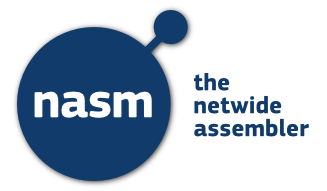
NASM (Netwide Assembler) is a multi-platform assembler for x86 CPUs (i.e., the CPUs that power PCs and Apple Macs) in 32 and 64 bit modes. It is a free open source project, gaining popularity and providing a simplified Assembly language syntax. NASM alternatives are either not free or platform-restricted. Like most assemblers and compilers, NASM itself is a command-line tool, so we'll be using it indirectly from the SciTE IDE.
GDB (GNU Project Debugger) and DDD (Data Display Debugger) are GNU software for debugging applications developed in any computer language. GDB is the actual debugger but has a command-line interface that is hard to learn. DDD is the graphical interface to GDB, boasting a very small footprint in terms of disk space and memory — in fact this was a factor in every software choice I made as it increases the chances that you'll be able to use this virtual machine. You can launch it from the obvious desktop shortcuts or with Ctrl+Alt+G.
In past years, this class has evolved from:
There is a folder in the desktop named "ac" which stands for "Computer Architecture", in Portuguese. If it's empty, this means there have been recent changes to the teaching materials: please visit the page with my teaching materials for this class and load them here. You'll be guided how to proceed from there, in class.
Read also about how to use the Linux virtual machine.
For other teaching materials (in Portuguese), please follow this link.
O NASM (Netwide Assembler) é um assembler multi-plataforma para CPUs x86 (i.e., os CPUs que são usados em PCs e Apple Macs) nos modos de 32 e 64 bits. É um projecto de fonte aberta (open source) gratuito que está a ganhar popularidade e permite a utilização de uma sintaxe Assembly simplificada. As alternativas ao NASM ou não são gratuitas ou são restritas em termos de plataforma. Tal como a maior parte dos assemblers e compiladores, o NASM é uma ferramenta de linha de comandos pelo que o vamos usar indirectamente pelo IDE SciTE.
O GDB (GNU Project Debugger) e o DDD (Data Display Debugger) são software da GNU para depuração (debugging) de aplicações desenvolvidas em qualquer linguagem de programação. O GDB é o depurador (debugger) em si, mas tem uma interface de linha de comandos, o que o torna de difícil aprendizagem. O DDD é uma interface gráfica para o GDB que consegue ocupar muito pouco espaço em disco e memória — de facto, este foi um critério importante na escolha de todo o software, pois aumenta a probabilidade de que consigas utilizar esta máquina virtual. Podes correr o DDD a partir dos atalhos óbvios no ambiente de trabalho (desktop) ou com Ctrl+Alt+G.
Em anos anteriores, esta unidade curricular tem vindo a evoluir de:
Está uma pasta no ambiente de trabalho com o nome "ac" que significa "Arquitectura de Computadores". Se estiver vazia, isso significa que têm havido alterações recentes ao material de ensino: visita a página com os meus materiais de ensino para esta unidade curricular e carrega-os para essa pasta. Nas aulas serás guiado em como prosseguir.
Vê também como utilizar a máquina virtual Linux.
Para outros materiais de apoio ao ensino, por favor siga esta hiperligação.
Photography by NASA